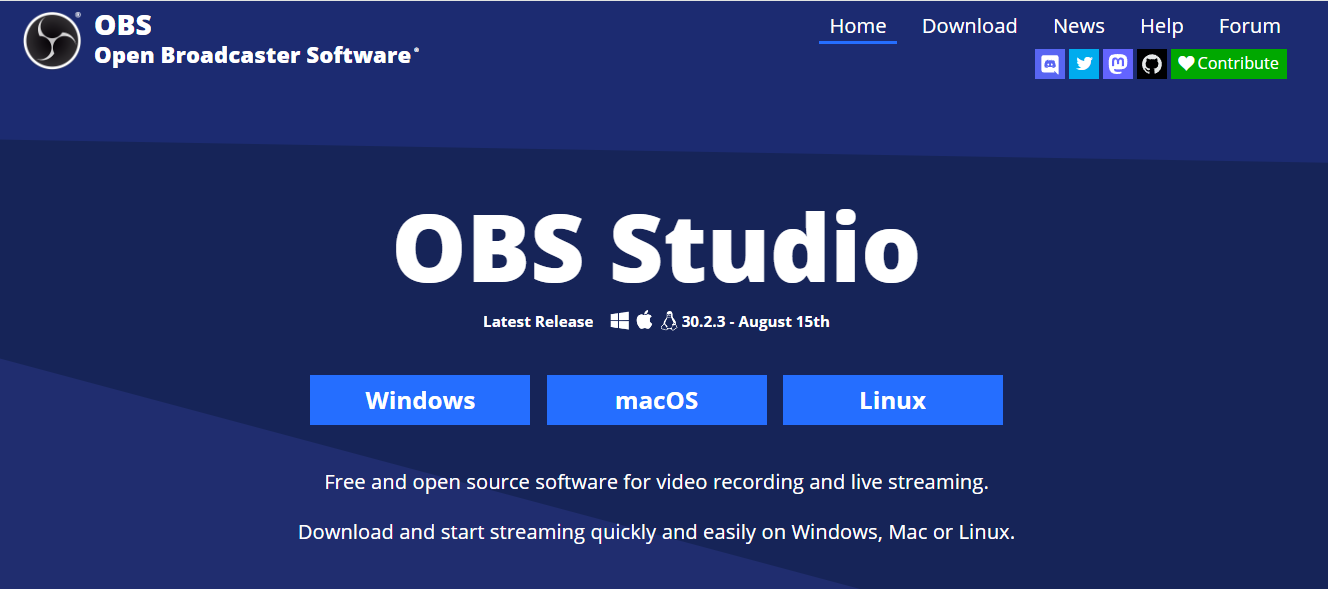
OBS (Open Broadcaster Software) is a free, open-source software suite used for live streaming and video recording. It is widely popular among content creators, gamers, educators, and professionals due to its versatility and extensive features. Open Broadcaster Software is available on multiple platforms, including Windows, macOS, and Linux, making it accessible for a broad range of users.
Here’s a deeper look at what OBS offers:
Key Features of Open Broadcaster Software:
- Live Streaming: OBS allows users to stream live to popular platforms such as YouTube, Twitch, Facebook Live, and more. It supports custom RTMP servers, giving users full control over where their streams are broadcasted.
- Video Recording: In addition to live streaming, OBS can record high-quality video, either simultaneously while streaming or separately for offline use.
- Multiple Input Sources: OBS can capture and mix multiple sources, such as screen captures, cameras, images, text, audio from your microphone, and media files (video, audio clips). This feature makes it ideal for streaming games, presentations, and tutorials.
- Customizable Scenes: Users can create multiple “scenes” in OBS, each containing different inputs and layouts. For example, one scene might show only the webcam, while another might display both the webcam and screen capture side by side. Scenes can be easily switched during a stream or recording.
- Audio Mixer: OBS includes a powerful audio mixer with per-source filters such as noise suppression and gain control, allowing users to control audio levels from various sources seamlessly.
- High-Performance Video Encoding: OBS uses powerful encoding, including support for H.264 and H.265 (using x264 and Intel Quick Sync Video), which ensures optimal performance and high-quality video output.
- Plugin Support: OBS has a wide range of plugins available that extend its capabilities, such as adding more effects, additional capture features, and integrations with other software or platforms.
- Studio Mode: This mode allows users to preview their scenes and sources before making them live, which is ideal for making sure everything looks perfect before broadcasting.
Why is Open Broadcaster Software So Popular?
- Free and Open Source: OBS is completely free to download and use, and as open-source software, it is continuously improved by a community of developers.
- Customizable: OBS provides users with endless customization options, from scene layouts to hotkeys, allowing users to tailor the software to their specific needs.
- Cross-Platform: Available for Windows, macOS, and Linux, OBS caters to a wide range of users across different operating systems.
- Widely Supported: Because of its popularity, OBS has an extensive community that provides tutorials, plugins, and troubleshooting support, making it easier for beginners to get started.
Use Cases of Open Broadcaster Software:
- Live Streaming: OBS is frequently used by gamers, YouTubers, and social media influencers to stream gameplay, interviews, or tutorials.
- Content Creation: Content creators use OBS to record high-quality videos for their YouTube channels or other platforms.
- Webinars and Virtual Classes: Teachers and professionals use OBS to create engaging webinars or record presentations, combining webcam footage, screen sharing, and slides.
- Podcasting: OBS is also used in video podcasting, allowing hosts to switch between different camera angles or share their screens with viewers.
Conclusion:
OBS (Open Broadcaster Software) is a highly versatile and powerful tool, offering everything you need to live stream or record high-quality video content—all at no cost free. Its wide array of features, from multi-source recording to real-time video editing, makes it an indispensable asset for anyone involved in content creation, whether you’re streaming games on Twitch, recording educational tutorials, or producing a live webinar. OBS’s flexibility allows users to tailor the software to all their specific needs with customizable scenes, audio mixing, and integration with various platforms.

